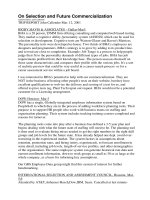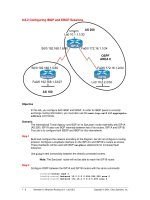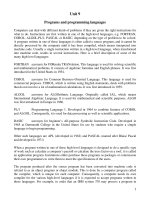Tài liệu Unemployment Fluctuations and Stabilization Policies pdf
Bạn đang xem bản rút gọn của tài liệu. Xem và tải ngay bản đầy đủ của tài liệu tại đây (3.45 MB, 119 trang )
Unemployment Fluctuations and
Stabilization Policies
Zeuthen Lecture Book Series
Karl Gunnar Persson, editor
Modeling Bounded Rationality
Ariel Rubinstein
Forecasting Non-stationary Economic Time Series
Michael P. Clements and David E. Hendry
Political Economics: Explaining Economic Policy
Torsten Persson and Guido Tabellini
Wage Dispersion: Why are Similar Workers Paid Differently?
Dale T. Mortensen
Competition and Growth: Reconciling Theory and Evidence
Philippe Aghion and Rachel Griffith
Product Variety and the Gains from International Trade
Robert C. Feenstra
Unemployment Fluctuations and Stabilization Policies:
A New Keynesian Perspective
Jordi Gal
´
ı
Unemployment Fluctuations and
Stabilization Policies
A New Keynesian Perspective
Jordi Gal´ı
The MIT Press
Cambridge, Massachusetts
London, England
c
2011 Massachusetts Institute of Technology
All rights reserved. No part of this book may be reproduced in any form by
any electronic or mechanical means (including photocopying, recording, or
information storage and retrieval) without permission in writing from the
publisher.
For information about special quantity discounts, please email
special
This book was set in Palatino by Aptara Inc. Printed and bound in the
United States of America.
Library of Congress Cataloging-in-Publication Data
Gal
´
ı, Jordi, 1961–
Unemployment fluctuations and stabilization policies : a new keynesian
perspective / Jordi Gal
´
ı.
p. cm. – (Zeuthen lectures)
Includes bibliographical references and index.
ISBN 978-0-262-01597-4 (hardcover : alk. paper) 1. Unemployment.
2. Unemployment – Government policy. 3. Monetary policy.
4. Keynesian economics. I. Title.
HD5707.5.G36 2011
339.5’3 – dc22 2010047659
10987654321
For Ellen
Contents
Series Foreword ix
Preface xi
Introduction 1
1 A Simple Model of Unemployment and
Inflation Dynamics 7
2 Unemployment, the Output Gap, and the
Welfare Costs of Economic Fluctuations 37
3 Unemployment and Monetary Policy Design
in the New Keynesian Model 61
4 Concluding Remarks and Directions for
Future Research 83
Appendix A 89
Appendix B 91
Appendix C 93
Appendix D 95
References 97
Index 103
Series Foreword
The Zeuthen Lectures offer a forum for leading scholars
to develop and synthesize novel results in theoretical and
applied economics. The Zeuthen Lectures are organized by
the Institute of Economics, University of Copenhagen. The
aim is to present advances in knowledge in a form accessible
to a wide audience of economists and advanced students of
economics. The topics range from abstract theorizing to eco-
nomic history. Regardless of the choice of topic, the empha-
sis in the lecture series is on originality and relevance.
The lecture series is named after Frederik Zeuthen, a former
professor at the Institute of Economics.
Karl Gunnar Persson
Preface
Presented in this book is a revised version of the Zeuthen
Lectures I delivered at the University of Copenhagen on
March 17 to 19, 2010. In these lectures I develop a ver-
sion of the standard New Keynesian model for which a
concept of unemployment can be defined, and show how
it can account reasonably well for the observed properties
of unemployment fluctuations. I use the same framework
also to construct unemployment-based measures of the
output gap, which are compared with more conventional
measures. Last, I study the gains from having the central
bank respond systematically to the unemployment rate, in
addition to other variables.
I am thankful to Karl Gunnar Persson, Christian Schultz,
Henrik Jensen, and others of the Department of Economics
at the University of Copenhagen for their comments and
hospitality during my visit. I have also benefited from com-
ments by seminar participants at the Riksbank, Federal
Reserve Board, CREI-UPF, ECB, and NBER Summer Insti-
tute. Tomaz Cajner, Alain Schlaepfer, and Lien Laureys pro-
vided excellent research assistance. The research leading
to this volume has received funding from the European
Research Council under the European Union’s Seventh
Framework Programme (FP7/2007-2013)/ ERC grant agree-
ment 229650.
Introduction
For the past fifteen years the New Keynesian model has
served as a frame of reference for analyses of fluctuations
and stabilization policies.
1
That framework has allowed the
rigor and internal consistency of dynamic general equi-
librium models to be combined with typically Keynesian
assumptions, like monopolistic competition and nominal
rigidities, thus setting the stage for a meaningful, welfare-
based analysis of the effects of alternative monetary pol-
icy rules. Indeed many central banks and policy institutions
have adopted medium-scale versions of that model for sim-
ulation and forecasting purposes.
2
1. For a textbook exposition of the New Keynesian model, see Walsh (2003),
Woodford (2003), Gal
´
ı (2008), and Walsh (2010). An early version and anal-
ysis of the baseline New Keynesian model can be found in Yun (1996), who
used a discrete-time version of the staggered price-setting model originally
developed in Calvo (1983). King and Wolman (1996) provided a detailed
analysis of the steady state and dynamic properties of the model. Good-
friend and King (1997), Rotemberg and Woodford (1999a), and Clarida,
Gal
´
ı, and Gertler (1999) were among the first to conduct a normative policy
analysis using that framework.
2. See, for example Smets and Wouters (2003, 2007) and Christiano, Eichen-
baum, and Evans (2005). For a descriptions of versions of those models
developed at policy institutions, see Christoffel, Coenen, and Warne (2008),
2 Introduction
But success breeds criticism, and the New Keynesian
model has been no exception. Among other shortcomings
the lack of reference to unemployment is often pointed to as
one of the model’s main weaknesses. This is not surprising
given the central role of that variable in the policy debate
and in public perceptions of the costs associated with busi-
ness cycles. Furthermore the conspicuous absence of unem-
ployment from the standard New Keynesian model could
even be interpreted as suggesting that central banks need
not monitor or respond to unemployment in a systematic
way. It may seem that through the lens of the New Keyne-
sian model, unemployment and the frictions underlying it
are not essential for understanding fluctuations in nominal
and real variables, nor a key ingredient in the design of mon-
etary policy.
Yet, over the past few years, a growing number of
researchers have sought to rectify that anomaly by devel-
oping frameworks that combine the nominal rigidities and
consequent monetary nonneutralities of the New Keyne-
sian model with labor market imperfections that give rise to
unemployment. Those frictions are generally introduced by
embedding a labor market with search and matching, in the
tradition of Mortensen and Pissarides (1994), into some ver-
sion of the New Keynesian model.
3
The resulting framework
has been used in both positive and normative applications,
with and without the assumption of wage rigidities.
4
In the present book I propose a different approach to intro-
ducing unemployment in the New Keynesian framework.
Edge, Kiley, and Laforte (2007), and Erceg, Guerrieri, and Gust (2006),
among others.
3. See Alexopoulos (2006) for an alternative approach, based on an effi-
ciency wage model of the labor market, albeit in the context of a monetary
model with no (exogenous) nominal rigidities.
4. Walsh (2003, 2005) and Trigari (2009) analyzed the impact of embedding
labor market frictions into the basic New Keynesian model with sticky
Introduction 3
My approach, based on Gal
´
ı (2011a), involves a reinterpre-
tation of the labor market in the standard New Keynesian
model with staggered wage setting, as originally formulated
by Erceg, Henderson, and Levin (2000), rather than a modi-
fication or an extension of that model. The resulting frame-
work preserves the convenience of the representative house-
hold paradigm, and allows one to determine the equilibrium
levels of employment, the labor force, and hence the unem-
ployment rate (as well as other macro variables of interest)
conditional on the monetary policy rule in place. Unem-
ployment in the model results from the presence of market
power in labor markets, reflected in a positive average wage
markup, namely a positive gap between the prevailing wage
and the disutility of work (expressed in terms of consump-
tion) for the marginal worker employed. On the other hand,
fluctuations in the unemployment rate are associated with
variations in that average wage markup due to the presence
of nominal wage rigidities.
5
prices but flexible wages, with a focus on the size and persistence of the
effects of monetary policy shocks.
More recent contributions have extended that work in two dimensions.
First, they have relaxed the assumption of flexible wages, and introduced
different forms of nominal and real wage rigidity. The work of Trigari (2006)
and Christoffel and Linzert (2005) falls into that category. Second, the focus
of analysis has gradually turned to normative issues, and more specifically,
to the implications of labor market frictions and unemployment for the
design of monetary policy. See, for example, the work of Blanchard and Gal
´
ı
(2010) in a model with real wage rigidities, Faia (2009, 2010), and Thomas
(2008).
More recently Christiano, Trabandt, and Walentin (2010) have modi-
fied the new Keynesian model by embedding in it an alternative model
of unemployment, where the probability of finding a job is increasing in
search effort, and where imperfect risk sharing among individuals is a con-
sequence of the unobservability of effort.
5. The general approach builds on Gal
´
ı (1996). Recent applications of that
approach to the New Keynesian model can be found in Blanchard and Gal
´
ı
(2007), Gal
´
ı (2011a), and, closely related to the latter (but developed inde-
pendently), Casares (2010).
4 Introduction
An important advantage of the proposed approach lies
in its compatibility with a variety of assumptions regarding
aspects of the model unrelated to unemployment, including
the specific forms of price and wage rigidities, household
utility, or the determinants of variable desired markups.
Still the proposed framework has limitations. In particu-
lar, it abstracts from potential sources of unemployment
other than noncompetitive wages, including those associ-
ated with the costly reallocation of labor across firms or sec-
tors (in terms of time and other resources) that can give rise
to frictional unemployment. It is important to recognize,
however, that the findings of the recent literature on labor
market frictions suggest that frictional unemployment is not
enough to generate unemployment fluctuations of the size
and persistence observed in the data, and that suggest need
for some kind of wage rigidity.
6
The content of the book following the present introduc-
tion is organized as follows. In chapter 1, I develop the
basic model of unemployment that is used throughout the
book, embedding it in a standard New Keynesian frame-
work with staggered price and wage setting, similar to
that in Erceg, Henderson, and Levin (2000). Using a cal-
ibrated version of the latter, I analyze its implied predic-
tions regarding the properties of unemployment in response
to shocks of diverse nature, when the central bank fol-
lows a conventional Taylor rule. The analysis puts special
emphasis on the role played by nominal wage rigidities in
accounting for the volatility and persistence of unemploy-
ment. A conclusion of that quantitative exercise is that real-
istic wage rigidities may potentially generate fluctuations in
unemployment with cyclical properties not much different
from those observed in the US and euro area economies.
6. See, for example, Hall (2005), Gertler and Trigari (2009), Gal
´
ı (2011b), and
Shimer (2005, 2010).
Introduction 5
In chapter 2, I explore the relationship between economic
fluctuations and efficiency using the New Keynesian frame-
work developed in the first chapter. In particular, I develop
a measure of the output gap, namely the deviation between
the efficient and the actual levels of output. Under some
assumptions, the output gap is shown to be a function of the
price and wage markups, which can be expressed in turn
in terms of two observable variables: the labor income share
and the unemployment rate. For the United States the result-
ing output gap turns out to be positively correlated with
“traditional” measures of economic slack, like the Hodrick–
Prescott detrended GDP, though this is not so much the case
for the euro area. In addition I consider the implications for
welfare of the output gap and its fluctuations, by comput-
ing a measure of the associated utility losses and analyzing
its changes over time. The findings of that exercise point
to small average welfare losses resulting from output gap
fluctuations, despite the substantial variations in the size of
those losses over the cycle; still the losses experienced in
recession episodes are far from negligible.
In chapter 3, I turn to the relation between unemploy-
ment and the design of monetary policy. This discussion
is partly motivated by the tight link, both theoretical and
empirical, between the output gap and the unemployment
rate as shown in the previous chapter. That link, together
with the near-optimality of output gap stabilization in an
environment with stickiness in both prices and wages (as
uncovered by the literature), points to the desirability of
policies that put some weight on unemployment stabiliza-
tion. Thus I begin with an analysis of unemployment and
several other macro variables under the optimal monetary
policy and compare it to that prevailing under a standard
Taylor rule. That analysis suggests the presence of likely
welfare gains from stabilizing the unemployment rate
6 Introduction
beyond what is implied by the Taylor rule. This is con-
firmed by the study of the properties of a more general inter-
est rate rule, one that allows for a systematic response to
unemployment and wage inflation, in addition to output
and price inflation. In particular, I show how a simple rule
that responds to price inflation and the unemployment rate
can approximate reasonably well the optimal policy rule.
Perhaps more surprisingly, the same simple rule is shown
to account quite accurately for the observed patterns in the
federal funds rate during the Greenspan era, at least until
the deflation scare of 2003.
Finally, in chapter 4, I offer some tentative conclusions,
review some of the shortcomings of the proposed approach,
and point to possible directions for future research.
1
A Simple Model of Unemployment and
Inflation Dynamics
The New Keynesian model with staggered wage and price
setting of Erceg, Henderson, and Levin (2000; henceforth,
EHL) constitutes the core of the dynamic stochastic general
equilibrium (DSGE) frameworks that have become popular
in recent years, and that have been adopted by many central
banks and policy institutions as an analytical tool. While the
EHL model lacks many of the bells and whistles that have
been incorporated in the estimated medium-scale models,
it remains useful in elucidating the implications of nominal
rigidities for the design of monetary policy.
1
The variant presented here, based on Gal
´
ı (2011a), treats
labor as being indivisible in that each period a given indi-
vidual works a fixed number of hours or does not work at
all. As a result all variations in labor input take place at the
extensive margin (i.e., in the form of variations in employ-
ment). Since that margin dominates the observed varia-
tions in total hours of work, the assumption of indivisible
labor remains a good first approximation. Most important,
1. See Christiano, Eichenbaum, and Evans (2005) and Smets and Wouters
(2003, 2007) for examples of estimated medium-scale models built on the
EHL model.
8 Chapter 1
however, that assumption leads to a definition of unemploy-
ment that is consistent with its empirical counterpart.
In the second half of the chapter, I analyze the equilib-
rium properties of unemployment in response to a variety
of shocks, using a calibrated version of the New Keynesian
model. I keep the focus on the relation between the degree
of nominal wage rigidities and the model’s implied volatil-
ity and persistence of unemployment.
Next I describe the components of a variant of the EHL
model. The model’s equilibrium is described by the same set
of equations as in EHL, to which I add an equation describ-
ing the evolution of unemployment. The reader is referred
to the original EHL paper for the details on some of the
derivations.
2
1.1 Households, Wage Setting, and Unemployment
The economy is assumed to have a large number of identical
households. Each household has a continuum of members
represented by the unit square and indexed by a pair (i, j) ∈
[0, 1] × [0, 1]. The first index, i ∈ [0, 1], represents the type
of labor service in which a given household member is spe-
cialized. The second index, j ∈ [0, 1], determines the disutil-
ity from work. The latter is given by χ
t
j
ϕ
if he is employed
and zero otherwise, where ϕ ≥ 0 and χ
t
> 0 is an exogenous
preference shifter (often referred to below as a labor sup-
ply shock). Utility from consumption is separable and log-
arithmic in a CES index of the quantities consumed of the
different goods available. As in Merz (1995) and much of
2. See also Gal
´
ı (2008, ch. 6) for a version of the EHL model consistent with
the notation used here.
A Simple Model of Unemployment and Inflation Dynamics 9
the subsequent literature, I assume full risk sharing within
the household. Given the separability of preferences, this
implies the same level of consumption for all household
members, independently of their work status. This is not
an innocuous assumption, especially from a welfare stand-
point, but one that I stick to in order to preserve the model’s
tractability.
3
The household’s period utility is given by the integral of
its members’ period utilities and can thus be written as
U(C
t
, {N
t
(i)}; χ
t
) ≡ log C
t
−χ
t
1
0
N
t
(i)
0
j
ϕ
djdi
= logC
t
−χ
t
1
0
N
t
(i)
1+ϕ
1 + ϕ
di,
where C
t
≡
1
0
C
t
(z)
1−(1/
p
)
dz
p
/(
p
−1)
, C
t
(z) is the quantity
consumed of good z, for i ∈ [0, 1], and N
t
(i) ∈ [0, 1] is the
fraction of members specialized in type i labor who are
employed in period t. Below I assume that ξ
t
≡ log χ
t
fol-
lows the AR(1) process:
ξ
t
= ρ
ξ
ξ
t−1
+ε
ξ
t
,
where ρ
ξ
∈ [0, 1] and ε
ξ
t
is a white noise process with zero
mean and variance σ
2
ξ
.
Each household is assumed to maximize
E
0
∞
t=0
β
t
U(C
t
, {N
t
(i)}; χ
t
)
3. See Christiano, Trabandt, and Walentin (2010) for an unemployment
model with separable preferences but different levels of consumption for
employed and not-employed household members.
10 Chapter 1
subject to a sequence of flow budget constraints given by
1
0
P
t
(z)C
t
(z)dz + Q
t
B
t
≤ B
t−1
+
1
0
W
t
(i)N
t
(i)di +
t
, (1.1)
where P
t
(z) is the price of good z, W
t
(i) is the nominal wage
for type i labor, B
t
represents purchases of a nominally risk-
less one-period discount bond paying one monetary unit, Q
t
is the price of that bond, and
t
is a lump-sum component of
income (which may include, among other items, dividends
from the ownership of firms). The sequence above of period
budget constraints is supplemented with a solvency condi-
tion which prevents the household from engaging in Ponzi
schemes.
Optimal demand for each good resulting from utility max-
imization takes the familiar form:
C
t
(z) =
P
t
(z)
P
t
−
p
C
t
, (1.2)
where P
t
≡
1
0
P
t
(z)
1−
p
dz
1/1−
p
denotes the price index for
final goods. Note also that (1.2) implies that total consump-
tion expenditures can be written as
1
0
P
t
(z)C
t
(z)dz = P
t
C
t
.
The household’s intertemporal optimality condition is
given by
Q
t
= β E
t
C
t
C
t+1
P
t
P
t+1
. (1.3)
As discussed below, I assume that the wage for each labor
type W
t
(i) is set by the workers specialized in that type
of labor (or a union representing them), whereas the cor-
responding employment level N
t
(i) is determined by the
A Simple Model of Unemployment and Inflation Dynamics 11
aggregation of firms’ labor demand decisions (and allocated
uniformly across households). Thus both W
t
(i) and N
t
(i) are
taken as given by each individual household.
More specifically, and following Calvo’s formalism (Calvo
1983), I assume that workers specialized in a given type of
labor (or the union representing them) reset their nominal
wage with probability 1 −θ
w
each period. That probability
is independent of the time elapsed since those workers last
reset their wage, in addition to being independent across
labor types. Thus a fraction θ
w
keep their wage unchanged
in any given period, making that parameter a natural index
of nominal wage rigidities.
When reoptimizing their wage in period t, workers choose
a wage W
∗
t
in order to maximize their households’ util-
ity (as opposed to their individual utility), taking as given
all aggregate variables, including the aggregate wage index
W
t
≡
1
0
W
t
(i)
1−
w
di
1/(1−
w
)
. That maximization problem is
subject to a sequence of flow budget constraints as in (1.1),
as well as a sequence of labor demand schedules of the form
N
t+k|t
=
W
∗
t
W
t+k
−
w
1
0
N
t+k
(z)dz, (1.4)
where N
t+k|t
denotes the quantity demanded in period t + k
of a labor type whose wage was last reset in period t and
N
t+k
(z) is firm z’s employment index defined below. Note
that (1.4) can be derived from cost minimization by firms, as
discussed below.
The first-order condition associated with the wage-setting
problem can be written as
∞
k=0
(βθ
w
)
k
E
t
N
t+k|t
C
t+k
W
∗
t
P
t+k
−M
w
MRS
t+k|t
= 0,
12 Chapter 1
where MRS
t+k|t
≡ χ
t
C
t
N
ϕ
t+k|t
is the period t +k marginal
rate of substitution between consumption and employment
for a worker whose wage is reset in period t, and M
w
≡
w
/(
w
−1), is the desired or frictionless wage markup,
namely the constant ratio between the real wage and the
marginal rate of substitution that would obtain under flexi-
ble wages (corresponding to θ
w
= 0).
Log-linearizing the optimality condition above around
the perfect foresight zero inflation steady state, and using
lower case letters to denote the logs of the original variables,
we obtain the approximate wage-setting rule
w
∗
t
= μ
w
+(1 −βθ
w
)
∞
k=0
(βθ
w
)
k
E
t
mrs
t+k|t
+ p
t+k
, (1.5)
where μ
w
≡ log M
w
. Note that in the absence of nominal
wage rigidities (θ
w
= 0), we have w
∗
t
= w
t
= μ
w
+mrs
t
+ p
t
,
implying a constant (log) markup μ
w
of the wage w
t
over
the price-adjusted marginal rate of substitution, mrs
t
+ p
t
.
When nominal wage rigidities are present, new wages are
set instead as a constant markup μ
w
over a weighted aver-
age of current and expected future price-adjusted marginal
rates of substitution.
I define the economy’s average marginal rate of substitu-
tion as MRS
t
≡ χ
t
C
t
N
ϕ
t
, where N
t
≡
1
0
N
t
(i)di is the aggre-
gate employment rate. Thus we can write (after taking logs)
mrs
t+k|t
= mrs
t+k
+ϕ(n
t+k|t
−n
t+k
) (1.6)
= mrs
t+k
−
w
ϕ(w
∗
t
−w
t+k
).
Furthermore, log-linearizing the expression for the aggregate
wage index around a zero inflation steady state, we obtain
w
t
= θ
w
w
t−1
+(1 −θ
w
)w
∗
t
. (1.7)









